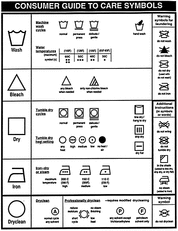FAQ'S - DRY CLEANING & SHIRT LAUNDRY

Q. I recently discovered that a winter white 100% wool jacket that I hadn't worn since it was last dry cleaned several years ago had developed areas of discoloration because I didn't remove it from the dry cleaning bag. I took it back to my dry cleaners to see if they could remove the stains but had no luck. Is it possible to save this jacket or is too late? Could possibly re-dyeing the fabric in winter white fix the problem? I hate to throw it away because I have already been online searching for a replacement (it is a Evan-Picone jacket) and it is now considered vintage.
Thanks for you help.
A. Thank you for your inquiry. There are actually two things that may be able to be done to restore your jacket. The first would be a special process using reducing bleach. The second process would be dying the fabric a dark color, preferably black. There is no process to re-dye a fabric winter white; you must dye it a darker color in order to cover the stains. If you would like to proceed, just send a copy of this e-mail along with your garment. You can get a shipping label and a mail order form from our website, click on the Free Shipping tab, and follow the instructions.
Thanks for you help.
A. Thank you for your inquiry. There are actually two things that may be able to be done to restore your jacket. The first would be a special process using reducing bleach. The second process would be dying the fabric a dark color, preferably black. There is no process to re-dye a fabric winter white; you must dye it a darker color in order to cover the stains. If you would like to proceed, just send a copy of this e-mail along with your garment. You can get a shipping label and a mail order form from our website, click on the Free Shipping tab, and follow the instructions.
|
Q. What do the "Care Label" symbols in my garments mean?
A. Care Label Symbols are required by law for your information to help you make informed garment purchase decisions. The Federal Trade Commission (FTC) requires manufacturers to attach a permanent label to textile garments that provides directions for their care. According to law, manufacturers and importers must list at least one method of safe care for a garment. It also requires that the label must be easily found and that it will remain legible during the garment's useful life. The label must warn about any part of the recommended care method that would harm the garment or other garments being laundered or dry cleaned with it. It must also warn when there is no method for cleaning a garment without damaging it.
| |||||||
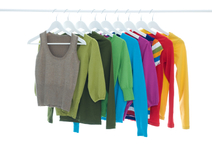
Q. Tell me what fabrics are recommended for drycleaning, please?
A. Wool, silk, rayon and acetate fabrics are at the top of the list. Also any fabrics trimmed in suede or leather or fur, any fabric with feathers, fancy beading, pearls, rhinestones or glittery/shiny decorations such as sequins and mirrors, fine "designer" knit suits and, nearly all sweaters (because they need to be blocked).
A. Wool, silk, rayon and acetate fabrics are at the top of the list. Also any fabrics trimmed in suede or leather or fur, any fabric with feathers, fancy beading, pearls, rhinestones or glittery/shiny decorations such as sequins and mirrors, fine "designer" knit suits and, nearly all sweaters (because they need to be blocked).
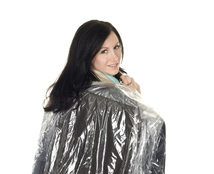
Q. Does the drycleaning process and chemicals cause undue wear on my clothes?
A. No. Drycleaning can extend the life of your clothing. Food and beverage spills or tiny crumbs will attract insect damage unless the garment is drycleaned. A study conducted by a large eastern university found that wool fabric was unaffected by repeated drycleanings. The series of solvent cleanings did cause some minor color change. Colors will change if the original dye lot is not colorfast or may be noticed if matching pieces are cleaned with different solvents.
A. No. Drycleaning can extend the life of your clothing. Food and beverage spills or tiny crumbs will attract insect damage unless the garment is drycleaned. A study conducted by a large eastern university found that wool fabric was unaffected by repeated drycleanings. The series of solvent cleanings did cause some minor color change. Colors will change if the original dye lot is not colorfast or may be noticed if matching pieces are cleaned with different solvents.

Q. Drycleaning vs. Wetcleaning: what is the difference?
A. Drycleaning means your garments are immersed or machine "washed" in a solvent mixture designed to prevent harm to natural fibers such as silk and wool. After the cleaning, the solvent is extracted taking the soil with it. Clothes are then dried and pressed. Wet cleaning may be a solvent-and-water process, or water-and-commercial detergent. Again, the clothes are dried and then pressed. Fancy detail work is always hand-pressed at Arrow.
A. Drycleaning means your garments are immersed or machine "washed" in a solvent mixture designed to prevent harm to natural fibers such as silk and wool. After the cleaning, the solvent is extracted taking the soil with it. Clothes are then dried and pressed. Wet cleaning may be a solvent-and-water process, or water-and-commercial detergent. Again, the clothes are dried and then pressed. Fancy detail work is always hand-pressed at Arrow.
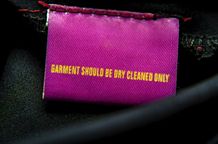
Q. My new shirt has a care label that says "Dry Clean Only". It doesn't give further care instructions. The fabric content label says it's made of rayon and nylon. I can launder this at home, right?
A. The garment manufacturer thinks drycleaning is the best solution. In 1972, to protect consumers, the Federal Trade Commission began requiring care tags in all finished garments sold in the United States. The ruling was changed in 1984 to allow labeling to carry only one recommended care method. Arrow will follow the manufacturer care label for best results. Gentle hand-washing at home may be satisfactory, but there's no way to know if the shirt will retain its shape and color. Some fabric interfacing used in manufacturing will distort in liquids and needs high heat to restore the shape.
A. The garment manufacturer thinks drycleaning is the best solution. In 1972, to protect consumers, the Federal Trade Commission began requiring care tags in all finished garments sold in the United States. The ruling was changed in 1984 to allow labeling to carry only one recommended care method. Arrow will follow the manufacturer care label for best results. Gentle hand-washing at home may be satisfactory, but there's no way to know if the shirt will retain its shape and color. Some fabric interfacing used in manufacturing will distort in liquids and needs high heat to restore the shape.
STAINS & DISCOLORATION

Q. I have a professional suit jacket and slacks in summer white linen. I took the slacks to Arrow but not the jacket. Now the two pieces are different colors of white!
A. Today's "summer" whites may contain fluorescent brighteners that can be damaged by prolonged natural sunlight. If you own matching sets of clothing such as suits, sweater sets, or dresses with matching jackets, always have them cleaned at the same time, whether or not they appear to be soiled. Dyes and fabric finishes will change over time and with repeated wearings. To keep your matching sets looking as new as possible, clean them together.
A. Today's "summer" whites may contain fluorescent brighteners that can be damaged by prolonged natural sunlight. If you own matching sets of clothing such as suits, sweater sets, or dresses with matching jackets, always have them cleaned at the same time, whether or not they appear to be soiled. Dyes and fabric finishes will change over time and with repeated wearings. To keep your matching sets looking as new as possible, clean them together.
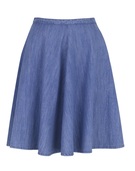
Q. I have a stain on my favorite skirt. It was cleaned but the stain didn't come out.
A. You may bring the skirt to Arrow and ask for spot treatment and re-cleaning. If you know the cause of the stain (wine, ink, etc.), that information will be helpful in the spotting process. Once a stain has been "set" with heat, we cannot guarantee complete removal and may ask you to sign a customer-consent form. In this case, calling attention to the stained area before the cleaning probably would have prevented the discoloration.
A. You may bring the skirt to Arrow and ask for spot treatment and re-cleaning. If you know the cause of the stain (wine, ink, etc.), that information will be helpful in the spotting process. Once a stain has been "set" with heat, we cannot guarantee complete removal and may ask you to sign a customer-consent form. In this case, calling attention to the stained area before the cleaning probably would have prevented the discoloration.

Q. I have a 100% cotton shirt with a gross-looking gray area at the air pits. I do perspire but I also use antiperspirant. What is up with the sweat rings?
A. The cellulose in all-cotton fabrics is prone to weakening by the chemicals found in antiperspirants. Also, sweat itself can damage your clothes. If you wear silk shirts, we recommend that you wear underarm shields to prevent staining.
A. The cellulose in all-cotton fabrics is prone to weakening by the chemicals found in antiperspirants. Also, sweat itself can damage your clothes. If you wear silk shirts, we recommend that you wear underarm shields to prevent staining.

Q. White wine spilled on the jacket of my best suit. It doesn't show because I immediately mopped it up. Should I worry about a spot?
A. The garment owner should note any spills on fabrics before having the garment cleaned professionally. For example, if not pre-spotted, sugar residue will darken (caramelize) when heat is applied at pressing. The more information you can provide to Arrow, the better your suit will look after cleaning and pressing.
A. The garment owner should note any spills on fabrics before having the garment cleaned professionally. For example, if not pre-spotted, sugar residue will darken (caramelize) when heat is applied at pressing. The more information you can provide to Arrow, the better your suit will look after cleaning and pressing.
PLASTIC BAGS
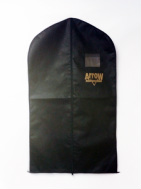
Q. My friend says I shouldn't leave my cleaned clothes in the plastic bag. I don't believe the plastic can cause any damage and it keeps the cat hair from attaching itself to my clean, hanging clothes.
A. Arrow may be able to help you with the plastic-bag-syndrome. Go to our website and order some of the inexpensive garment bags. They're re-usable and can travel, too. To answer your question, the plastic bags are meant only to protect your clothing while transiting from the drycleaner to the home. If you feel compelled to use the plastic bags, we suggest you cut off the bag just below the shoulder. That will protect the clothing from dust. We might add, too, that the clothing will look and hang best when transferred from the wire drycleaning hangers to wooden or padded hangers.
A. Arrow may be able to help you with the plastic-bag-syndrome. Go to our website and order some of the inexpensive garment bags. They're re-usable and can travel, too. To answer your question, the plastic bags are meant only to protect your clothing while transiting from the drycleaner to the home. If you feel compelled to use the plastic bags, we suggest you cut off the bag just below the shoulder. That will protect the clothing from dust. We might add, too, that the clothing will look and hang best when transferred from the wire drycleaning hangers to wooden or padded hangers.

